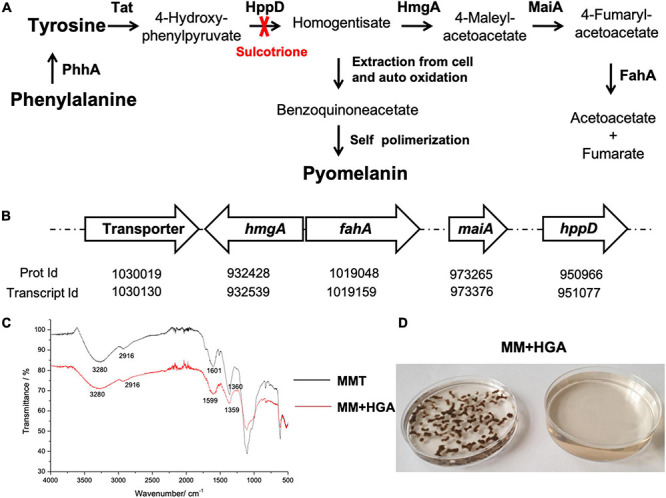FIGURE 1.

Pyomelanin synthesis in A. alternata by L-Tyrosine degradation to HGA. (A) L-Tyrosine degradation pathway and pyomelanin synthetic pathway. The enzymes indicated in bold as follows: PhhA, phenylalanine hydroxylase; Tat, L-tyrosine aminotransferase; HppD, 4-hydroxyphenylpyruvate dioxygenase; HmgA, homogentisate dioxygenase; MaiA, maleylacetoacetate isomerase; FahA, fumarylacetoacetate hydrolase. (B) Arrangement of the genes putatively involved in these pathways in A. alternata. The pyomelanin pigment derives from L-tyrosine through formation of 4-hydroxyphenylpyruvate and HGA which conversion is inhibited by sulcotrione. HGA is catabolized into acetoacetate and fumarate and depending on the HmgA activity, HGA may accumulates and can be secreted from the cell (Yabuuchi and Ohyama, 1972). Then, after auto-oxidation into benzoquinoneacetate and self-polymerization, forms a brown pigment, pyomelanin (Rodríguez et al., 2000). The genes encoding the enzymes involved in these pathways were found in A. alternata SRC1lrK2f v1.0 genome, at JGI: http://genome.jgi.doe.gov (The Genome Portal of the Department of Energy Joint Genome Institute). The transporter (Prot Id 985975) may be involved in the transport of HGA out of the cell. (C) FTIR spectra of the pigments obtained from culture medium of A. alternata grown in MMT (black) and in MM + HGA (red). (D) Culture medium and mycelia of A. alternata grown in MM + 5.5 mM HGA.
